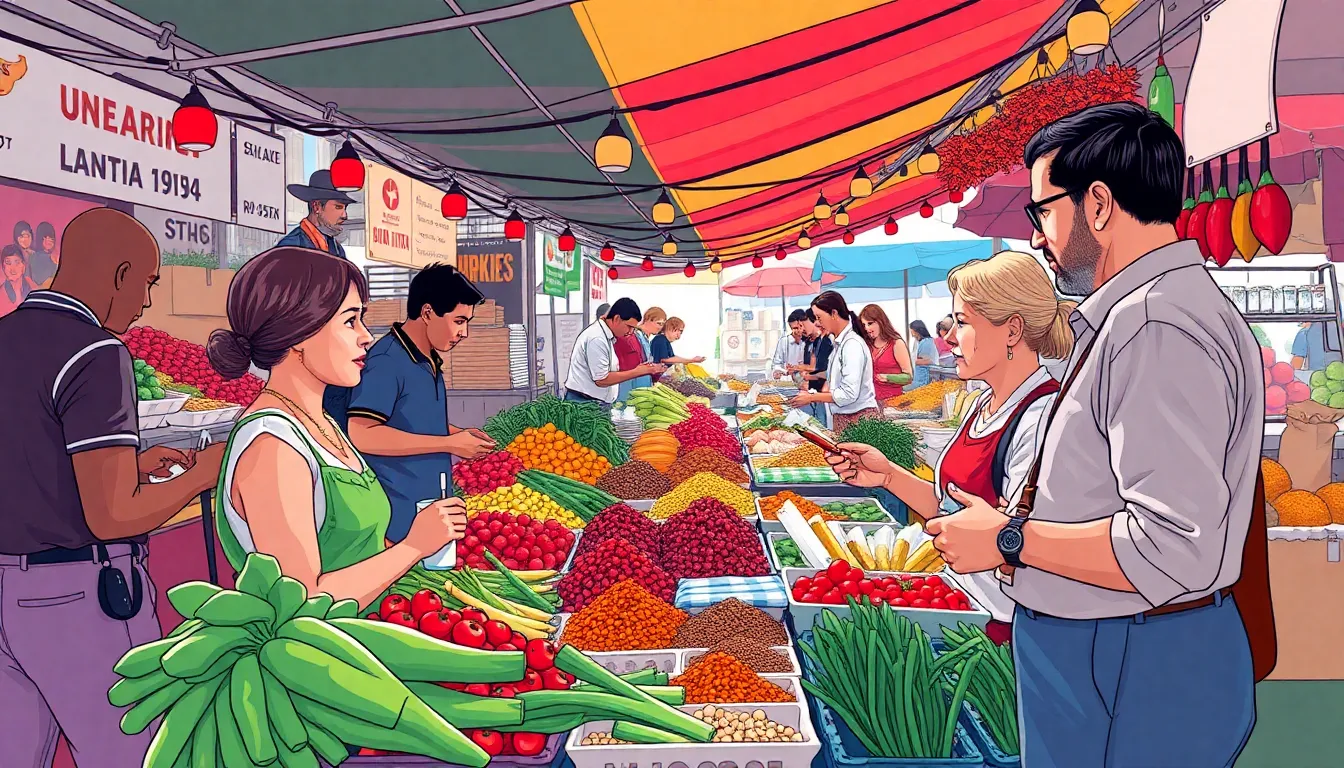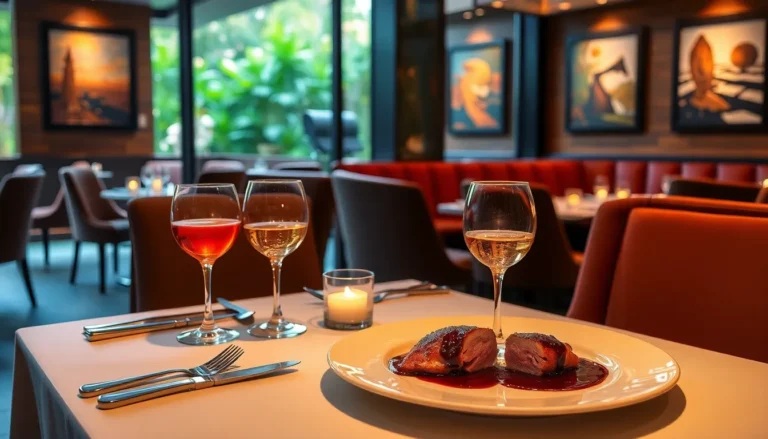Table of Contents
ToggleImagine taking a culinary trip around the world without ever leaving your kitchen. Global cuisine offers a passport to flavors, aromas, and traditions that span continents. From the spicy curries of India to the delicate sushi of Japan, each dish tells a story that connects cultures and ignites taste buds.
Overview of Global Cuisine
Global cuisine encompasses a vast array of culinary traditions from diverse cultures. Each region presents unique ingredients, flavors, and cooking techniques that tell a story within its dishes. Indian cuisine showcases rich spices and vibrant colors, while Italian dishes offer a range of rustic flavors through fresh herbs and seasonal ingredients.
The diversity of global cuisine frequently reflects historical influences and migration patterns. Middle Eastern food, for example, often combines spices from trade routes that shaped its flavors. Traditional French cuisine emphasizes technique, featuring sauces and pastries crafted with precision.
Street food serves as an essential aspect of many global cuisines, connecting communities through shared culinary experiences. Thai street food bursts with flavor profiles, ranging from sweet to sour, drawing food lovers from around the world. In Japan, izakayas provide a casual dining atmosphere, where small plates of various dishes enhance social dining.
Fusion cuisine marks a growing trend that blends elements from multiple culinary traditions. By combining techniques and ingredients, chefs create innovative dishes, such as Korean tacos. This blending enriches the global culinary landscape, inviting curiosity and exploration.
Global cuisine not only pleases the palate but also celebrates cultural heritage. Every meal reflects the essence of a destination, allowing individuals to savor dishes inspired by generations. Culinary exploration fosters appreciation of diversity, encouraging everyone to embark on a journey through food. As palates expand, so does the understanding of world cultures.
Influences on Global Cuisine

Global cuisine reflects the complexity of various cultural influences, showcasing an intricate tapestry of flavors and cooking methods. The interplay of local traditions and global interactions enriches culinary experiences.
Regional Traditions
Regional culinary traditions arise from local ingredients and cultural practices. Mediterranean cuisine, for instance, emphasizes fresh vegetables and olive oil, shaped by the region’s climate and agriculture. Asian cuisines, like Thai and Indian, highlight unique spices and cooking techniques, influenced by historical trade routes. African dishes often incorporate roots, grains, and a variety of meats, reflecting indigenous practices. Understanding these traditions fosters appreciation for the diversity that each region brings to the global culinary stage.
Cultural Exchanges
Cultural exchanges significantly influence global cuisine through migration and trade. The introduction of new ingredients, like tomatoes and potatoes, transformed European cooking, originally from the Americas. Trade routes facilitated spice exchanges, shaping dishes across continents, from Indian curry to Portuguese piri-piri. Shared culinary techniques, such as stir-frying and grilling, demonstrate the impact of cultural interactions. As cultures blend, they create new flavors and dishes that resonate far beyond their origins, enriching global cuisine.
Popular Dishes from Around the World
Global cuisine presents a tapestry of flavors and dishes that reflect cultural narratives. Each region offers unique culinary treasures worth exploring.
Asian Delicacies
Sushi exemplifies Japanese finesse, consisting of vinegared rice paired with fresh fish or vegetables. India’s rich curries, infused with spices like cumin and turmeric, provide a bold flavor profile. Thai tom yum soup features a tangy broth filled with shrimp, herbs, and chili, capturing vibrant tastes. Pho, a Vietnamese noodle soup, combines savory broth with fragrant basil and sliced meat for a comforting meal. Noodles appear in various forms, including Chinese stir-fried varieties that marry vegetables and proteins in savory sauces.
European Classics
Italy boasts iconic pasta dishes such as spaghetti carbonara, rich with eggs, cheese, and pancetta. French cuisine offers coq au vin, a slow-cooked chicken dish braised in red wine, showcasing techniques perfected over centuries. Spain introduces paella, a rice dish brimming with saffron, seafood, and vegetables, representing coastal flavors. English fish and chips present a delightful batter-fried fish alongside crispy potatoes, creating comfort food at its best. German sausages, varied and savory, highlight regional ingredients and customs.
Latin American Flavors
Tacos stand out in Mexican cuisine, wrapped in soft tortillas and filled with flavorful meats and toppings like salsa and avocado. Brazilian feijoada presents a hearty black bean stew, slow-cooked with pork and beef, alongside rice and orange slices. Argentine asado features grilled meats, seasoned simply to highlight their quality and taste. Peruvian ceviche provides freshness with marinated fish, citrus, and onions, embodying coastal impact. Traditional arepas from Venezuela showcase corn meal, stuffed with diverse fillings, creating a versatile staple for any meal.
Fusion Cuisine
Fusion cuisine blends elements from different culinary traditions, creating innovative dishes that celebrate diversity. This culinary style reflects the cultural exchanges and influences shaping global food trends.
Definition and Examples
Fusion cuisine combines ingredients, techniques, or flavors from various cultures to create unique meals. For instance, Korean tacos feature marinated meats and kimchi wrapped in traditional tortillas. Another example includes sushi burritos, which merge the fresh ingredients of sushi with the hand-held convenience of a burrito. These dishes highlight how chefs creatively incorporate diverse elements to appeal to modern palates.
Benefits and Challenges
Fusion cuisine offers numerous advantages while also presenting notable challenges. It encourages creativity, allowing chefs to experiment with new flavor combinations. Diners benefit from exciting culinary experiences through diverse tastes. However, balancing flavors from different traditions can be difficult. Some combinations may not resonate with traditionalists who prefer authentic dishes. Additionally, maintaining ingredient quality can pose challenges, especially when sourcing unique items from various regions.
Gastronomic Trends in Global Cuisine
Growing interest in plant-based diets influences global cuisine trends. Chefs increasingly incorporate vegetables, grains, and legumes into traditional dishes, enhancing flavors while promoting sustainability. For instance, many restaurants now feature plant-based versions of beloved comfort foods, appealing to a broader audience.
Cultural appreciation drives the popularity of authentic culinary experiences. Diners seek immersive food journeys, exploring local markets and cooking classes that connect them to diverse traditions. This trend highlights the importance of understanding the origins and stories behind each dish.
Health consciousness shapes modern culinary creations as well. Nutritional awareness prompts the use of whole foods and natural ingredients, resulting in lighter and healthier versions of classic meals. Additionally, the rise of superfoods, such as quinoa and avocado, reflects increased demand for nutrient-dense options.
Global food festivals showcase a variety of culinary styles and traditions. Events like Taste of London and the New York City Wine and Food Festival celebrate regional cuisines, allowing chefs to share their creations with a wider audience. These festivals create opportunities for cultural exchange, enriching participants’ culinary knowledge.
Local sourcing emphasizes fresh ingredients from nearby farms and producers. Chefs prioritize seasonal offerings, further enhancing flavors while supporting community agriculture. This approach also fosters a connection to the land, showcasing local heritage through food.
Innovation and technology play significant roles in shaping modern gastronomy. Incorporating techniques such as molecular gastronomy and sous-vide cooking allows chefs to experiment and elevate traditional dishes. This fusion of art and science keeps culinary experiences dynamic and engaging, attracting adventurous food lovers.
Exploring global cuisine offers a unique opportunity to savor the world’s diverse flavors and traditions. Each dish tells a story rooted in its culture and history, inviting individuals to embark on a culinary adventure. From the vibrant spices of Indian curries to the delicate artistry of sushi, the variety is endless.
The rise of fusion cuisine and innovative cooking techniques continues to reshape the culinary landscape, encouraging creativity and experimentation. As food lovers seek authentic experiences and sustainable options, global cuisine remains a dynamic field that reflects both heritage and modern trends. Embracing these culinary delights not only satisfies the palate but also fosters a deeper appreciation for cultural diversity.








